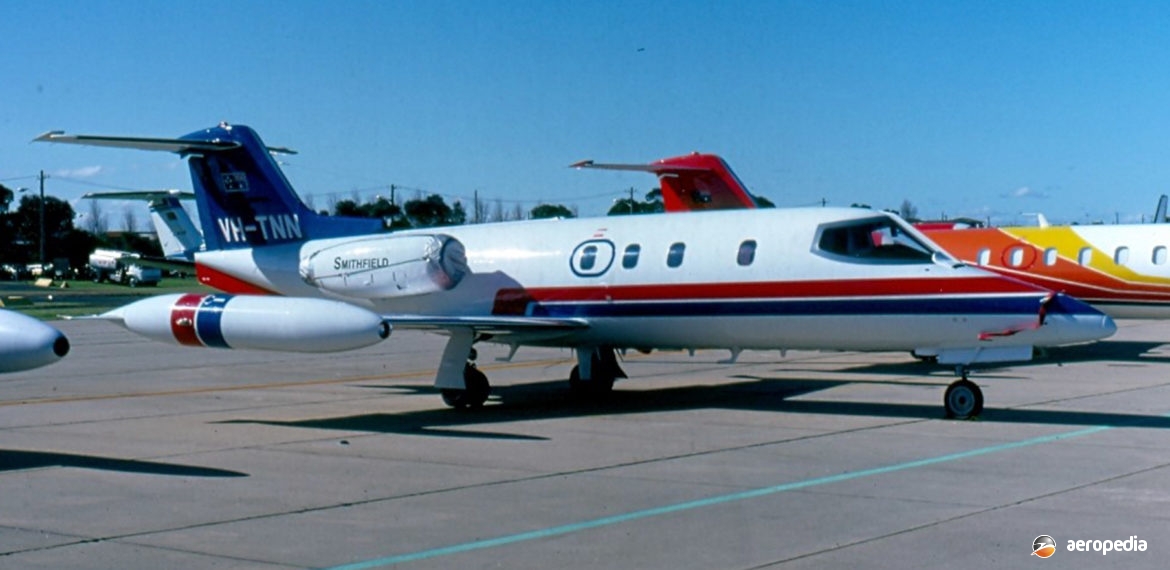Photograph:
Learjet 25C VH-TNN (c/n 181) at Mascot, NSW in July 1982 (David C Eyre)
Country of origin:
United States of America
Description:
Business and executive jet
Power Plant:
Two 2,950 lbst General Electric CJ-610-6 turbojets with optional thrust reversers
Specifications:
- [25F]
- Wingspan: 10.84 m (35 ft 7 in)
- Length: 14.50 m (47 ft 7 in)
- Height: 3.73 m (12 ft 3 in)
- Wing area: 21.53 m² (231.77 sq ft)
- Max speed: 909 km/h (565 mph)
- High speed cruise [Mach 0.82]: 859 km/h (534 mph)
- Balanced field length at max weight: 1,205 m (3,950 ft)
- Initial rate of climb: 1,844 m/min (6,050 ft/min)
- Single-engine climb rate: 533 m/min (1,750 ft/min)
- Operational ceiling: 13,725 m (45,000 ft)
- Single engine ceiling: 7,168 m (23,500 ft)
- Time to 12,505 m (41,000 ft): 19 mins
- Approach speed: 183 km/h (114 mph)
- Landing distance: 763 m (2,500 ft)
- Range with four passengers and 45 mins reserve: 3,593 km (2,233 miles)
- Fuel capacity: 3,180 litres (1,228 Imp gals)
- Empty weight: 3,465 kg (7,639 lb)
- Loaded weight: 6,805 kg (15,000 lb)
History:
For many years the Learjet was marketed as the fastest business jet in production. It was designed by William P Lear in Switzerland as the SAAC-23, being eventually produced in Wichita, Kansas, the prototype Model 23 flying for the first time on 7 October 1963. A prototype of what would become the Model 25 was flown in May 1966, this being a converted Model 24 with a 0.61 m (2 ft) fuselage extension and longer and larger diameter wingtip tanks, but testing revealed its handling characteristics were not what was desired.
On 12 August 1966 the prototype of the Model 25 was flown, this having a fuselage stretch of 1.27 m (4 ft 2 in) to permit eight passengers to be accommodated in lieu of the Model 24s six. The original large oval windows were replaced with smaller rectangular units and the original wingtip tanks. At this stage it was close to the definitive standard for the new model. It was followed on the production line by the Models 25B, 25D and 25F.
However, at this time in 1967 the Company was suffering financial problems and was taken over by Gates Rubber Company, the new Company becoming known as Gates Learjet Corporation. This Company was later in 1990 taken over by Bombardier of Canada. The first true Learjet 25 flew in March 1967 and certification was received in October that year. Powerplant initially was the CJ610-4 engine but later it went to the CJ610-6. A Model 25 set a number of performance records, particularly time-to-climb for its class, reaching 1,219 m (40,000 ft) in 6 mins 19 secs.
The Model 25 was part of what became known as the “Century III” series, the name indicating its introduction in the US Bicentennial year of 1976. Deliveries began in July that year. The Century III series had a re-cambered leading edge on the wing as far back as the second of the eight spars, this deepening the nose section of the profile. Other improvements included a stall warning/prevention system, the new profile of the aircraft increasing the aircraft’s lateral stability and handling qualities at the lower end of the speed range, this in turn permitting substantial reductions in take-off and landing weights.
This series was produced in a range comprising the Models 25D and 25F, which were basically equivalent to the Model 25B and 25C. The General Electric CJ610 engines complied with FAR 36 noise standards without using sound suppressors. Thrust reversers became available on this series. The series remained in production until 1987 when 368 examples had been delivered, comprising: Model 25 – 64 built; Model 25B – 112 built; Model 25C – 24 built; Model 25D – 168 built; Model 25E designation not used; Model 25F – none completed.
The Model 25G was a joint development of the Model 25D with Dee Howard, announced in 1980, with a modified wing, additional fuel and other changes; only one was completed, this being a conversion of a Model 25D. The Learjet 26 was a Model 25 converted to 3,500 lbst Garrett AiResearch TFE731-2 turbofans produced as part of the development program for the Models 35 and 36.
A number of Model 25s have been registered in Australia over the years. These have included: Model 25B VH-OVS (c/n 120) was registered to Shortstop Jet Charter Pty Ltd on 25 November 1988, but was exported to the United States as N101FU on 2 February 1996.
Model 25B VH-BLJ (c/n 180) was registered to BS Stillwell & Co Pty Ltd on 14 September 1974 but was exported to the United States as N95BS on 24 April 1980. It returned to Australia on 25 June 1987, becoming VH-LJB to Lloyd Aviation Jet Charter Pty Ltd. It was exported again to the United States on 30 May 1989 as N266BS.
Model 25C VH-TNN (c/n 181) was registered to E H and N A Neill on 10 October 1974, being operated by Stillwell Aviation. Ownership was changed on 15 November 1974 to BS Stillwell & Company Pty Ltd; and to Hancock Prospecting Pty Ltd on 20 July 1984. It was exported to the United States on 3 January 1985 as N94PK.

